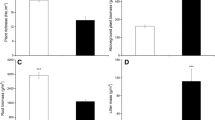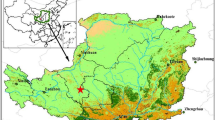Abstract
Grazing is one of the most important factors influencing community structure and productivity in natural grasslands. Fencing to exclude grazers is one of the main management practices used to protect grasslands. Can fencing improve grassland community status by restraining grazing? We conducted a field community study and indoor soil analyses to determine the long-term effects of fencing and grazing on the above-ground community and soil in a Kobresia-dominated meadow in the Qinghai-Tibetan Plateau, NW China. Our results showed that fencing significantly improved above-ground vegetation productivity but reduced plant density and species diversity. Long-term fencing favored the improvement of forage grass functional groups and restrained the development noxious weed functional groups. There were significant positive effects of fencing on below-ground organic matter, total nitrogen, available nitrogen, total phosphorus and available phosphorus. The productivity of grazed meadow showed a weak decrease over time. There were long-term decreasing trends for plant density both in fenced and grazed meadows. Our study suggests that grazing can be considered as a useful management practice to improve species diversity and plant density in long-term fenced grasslands and that periodic grazing and fencing is beneficial in grassland management.





Similar content being viewed by others
References
Agriculture Chemistry Council, Soil Science Society of China (1983) General analysis methods of soil agriculture chemistry. Science, Beijing
Akiyama T, Kawamura K (2007) Grassland degradation in China: methods of monitoring, management and restoration. Grassl Sci 53:1–17 doi:10.1111/j.1744-697X.2007.00073.x
Bardgett RD, Wardle DA (2003) Herbivore-mediated linkages between aboveground and belowground communities. Ecology 84:2258–2268 doi:10.1890/02-0274
Begon M, Harper JL, Townsend CR (1990) Ecology: individuals, populations and communities. Blackwell Scientific Publications, Oxford
Bokdam J, Gleichman JM (2000) Effects of grazing by free-ranging cattle on vegetation dynamics in a continental north-west European heathland. J Appl Ecol 37:415–431 doi:10.1046/j.1365-2664.2000.00507.x
Buttolph LP, Coppock DL (2004) Influence of deferred grazing on vegetation dynamics and livestock productivity in an Andean pastoral system. J Appl Ecol 41:664–674 doi:10.1111/j.0021-8901.2004.00921.x
Distel RA, Boo RM (1996) Vegetation states and transitions in temperate semiarid rangelands of Argentina. In: West NE (ed) Rangelands in a sustainable biosphere. Society for Range Management, pp 117–118
Gallego L, Distel RA, Camina R, Rodrı’guez Iglesias RM (2004) Soil phytoliths as evidence for species replacement in grazed rangelands of central Argentina. Ecography 27:725–732 doi:10.1111/j.0906-7590.2005.03964.x
Gao YZ, Giese M, Lin S, Sattelmacher B, Zhao Y, Brueck H (2008) Belowground net primary productivity and biomass allocation of a grassland in Inner Mongolia is affected by grazing intensity. Plant Soil 307:41–50 doi:10.1007/s11104-008-9579-3
Gibson RS, Hewitt A, Sparling G et al (2001) Vegetation change and soil quality in central. Otago Tussock grasslands, New Zealand. Range J 22:190–204 doi:10.1071/RJ0000190
Grant SA, Torvell L, Sim EM et al (1996) Controlled grazing studies on Nardus grassland: Effects of between-tussock sward height and species of grazer on Nardus utilization and floristic composition in two fields in Scotland. J Appl Ecol 33:1053–1064 doi:10.2307/2404685
Grime JP (1979) Plant strategies and vegetation processes. Wiley, Chichester
Grime JP (1998) Benefits of plant diversity to ecosystems: immediate, filter and founder effects. J Ecol 86:902–910 doi:10.1046/j.1365-2745.1998.00306.x
Gufu O, Oler V, Nils C (2001) Relationships between biomass and plant species richness in aridzone grazing lands. J Appl Ecol 38:836–845 doi:10.1046/j.1365-2664.2001.00638.x
Harris WN, Moretto AS, Distel RA, Boutton TW, Boo RM (2007) Fire and grazing in grasslands of the Argentine Caldenal: effects on plant and soil carbon and nitrogen. Acta Oecol 32:207–214 doi:10.1016/j.actao.2007.05.001
Haugland E, Froud-Williams RJ (1999) Improving grasslands: the influence of soil moisture and nitrogen fertilization on the establishment of seedlings. J Appl Ecol 36:263–270 doi:10.1046/j.1365-2664.1999.00397.x
Hobbs RJ, Huenneke LF (1992) Disturbance, diversity, and invasion: implications for conservation. Conserv Biol 6:324–337 doi:10.1046/j.1523-1739.1992.06030324.x
Holdo RM, Holt RD, Coughenour MB et al (2007) Plant productivity and soil nitrogen as a function of grazing, migration and fire in an African savanna. J Ecol 95:115–128 doi:10.1111/j.1365-2745.2006.01192.x
Holt JA (1997) Grazing pressure and soil carbon, microbial biomass and enzyme activities in semiarid Northeastern Australia. Appl Soil Ecol 5:143–149 doi:10.1016/S0929-1393(96)00145-X
Hulme PD, Pakeman RJ, Torvell L et al (1999) The effects of controlled sheep grazing on the dynamics of upland Agrostis-Festuca grassland. J Appl Ecol 36:886–900 doi:10.1046/j.1365-2664.1999.00452.x
Huston MA (1994) Biological diversity, the coexistence of species on changing landscapes. Cambridge University Press, New York
Inderjit (2005) Plant invasions: habitat invasibility and dominance of invasive plant species. Plant Soil 277:1–5
Klein JA, Harte J, Zhao XQ (2004) Experimental warming causes large and rapid species loss, dampened by simulated grazing, on the Tibetan Plateau. Ecol Lett 7:1170–1179 doi:10.1111/j.1461-0248.2004.00677.x
Landsberg J, James CD, Maconochie J et al (2002) Scale-related effects of grazing on native plant communities in an arid rangeland region of South Australia. J Appl Ecol 39:427–444 doi:10.1046/j.1365-2664.2002.00719.x
Li XR, Kong DS, Tan HJ, Wang XP (2007) Changes in soil and vegetation following stabilization of dunes in the southeastern fringe of the Tengger Desert, China. Plant Soil 300:221–231 doi:10.1007/s11104-007-9407-1
Liu B, Wu N, Luo P, Tao YP (2007) Characteristics of soil nutrient distribution in high-altitude meadow ecosystems with different management and degradation scenarios. Chin J Eco-Agri 15:45–48 in Chinese with English abstract
Marty JT (2005) Effects of cattle grazing on diversity in ephemeral wetlands. Conserv Biol 19:1626–1632 doi:10.1111/j.1523-1739.2005.00198.x
Miller RH, Keeney DR (eds) (1982) Methods of soil analysis. Part 2: chemical and microbiological properties, 2nd edn. American Society of Agronomy, Soil Science Society of America, Madison, WI
Moretto AS, Distel RA (1997) Competitive interactions between palatable and unpalatable grasses native to a temperate semiarid grassland of Argentina. Plant Ecol 130:155–161 doi:10.1023/A:1009723009012
Moretto AS, Distel RA (2002) Soil nitrogen availability under grasses of different palatability in a temperate semiarid rangeland of central Argentina. Austral Ecol 27:509–514 doi:10.1046/j.1442-9993.2002.01207.x
Moretto AS, Distel RA, Didoné NE (2001) Decomposition and nutrient dynamic of leaf litter and roots from palatable and unpalatable grasses in a semi-arid grassland. Appl Soil Ecol 18:31–37 doi:10.1016/S0929-1393(01)00151-2
Niu SW, Ma LB, Zeng MM (2008) Effect of overgrazing on grassland desertification in Maqu County. Acta Ecol Sin 28:145–153
Oesterheld M, Sala OE (1990) Effects of grazing on seedling establishment: the role of seed and safe-site availability. J Veg Sci 1:353–358 doi:10.2307/3235711
Olff H, Ritchie M (1998) Effects of herbivores on grassland plant diversity. Trends Ecol Evol 13:261–265 doi:10.1016/S0169-5347(98)01364-0
Pettit NE, Froend RH, Ladd PG (1995) Grazing in remnant woodland vegetation: changes in species composition and life form groups. J Veg Sci 6:121–130 doi:10.2307/3236263
Reeves GW (2000) Bushcare Program: Mid-Term Review. CSIRO, Canberra. Retrieved 20 October 2000. http://www.nht.gov.au/mtrfinrpt/bushcarefinalreport.pdf
Schippers P, Joenje W (2002) Modelling the effect of fertiliser, mowing, disturbance and width on the biodiversity of plant communities of field boundaries. Agric Ecosyst Environ 93:351–365 doi:10.1016/S0167-8809(01)00339-5
Semmartin M, Garibaldi LA, Chaneton EJ (2008) Grazing history effects on above- and below-ground litter decomposition and nutrient cycling in two co-occurring grasses. Plant Soil 303:177–189 doi:10.1007/s11104-007-9497-9
Sheppard AW, Hodge P, Paynter Q et al (2002) Factors affecting invasion and persistence of broom Cyt isus scoparius in Australia. J Appl Ecol 39:721–734 doi:10.1046/j.1365-2664.2002.00750.x
Smith RS, Shiel RS, Millward D et al (2000) The interactive effects of management on the productivity and plant community structure of an upland meadow: an 8-year field trial. J Appl Ecol 37:1029–1043 doi:10.1046/j.1365-2664.2000.00566.x
Spooner P, Lunt I, Robinson W (2002) Is fencing enough? The short-term effects of stock exclusion in remnant grassy woodlands in southern NSW. Ecol Manage Restor 3:117–126 doi:10.1046/j.1442-8903.2002.00103.x
Sternberg M, Gutman M, Perevolotsky A et al (2000) Vegetation response to grazing management in a Mediterranean herbaceous community: a functional group approach. J Appl Ecol 37:224–237 doi:10.1046/j.1365-2664.2000.00491.x
Stohlgren TJ, Crosier C, Chong GW, Guenther D, Evangelista P (2005) Life-history habitat. matching in invading non-native plant species. Plant Soil 277:7–18 doi:10.1007/s11104-005-4893-5
Tainton NM, Morris CD, Hardy MB (1996) Complexity and stability in grazing systems. In: Hodgson J, Illius AW (eds) The ecology and management of grazing systems. CAB International, Wallingford, pp 275–299
Tilman D (1988) Plant strategies and the dynamics and structure of plant communities. Princeton University, Princeton
Van der Wal R, Bardgett RD, Harrison KA et al (2004) Vertebrate herbivores and ecosystem control: cascading effects on tundra ecosystems. Ecography 27:242–252
Wang CT, Cao GM, Wang QL, Jing ZC, Ding LM, Long RJ (2007) Research on variation of species composition and biomass along environmental gradient of plant community in alpine meadow of the Qinghai-Tibetan Plateau. Science in China Serices (C). Life Sci 37:585–592
Wang CT, Long RJ, Cao GM, Wang QL, Jing ZC, Shi JJ (2008) The relationship between soil nutrients and diversity—productivity of different type grasslands in alpine meadow. Chin J Soil Sci 39:1–8
Watkinson AR, Ormerod SJ (2001) Grasslands, grazing and biodiversity: editors’ introduction. J Appl Ecol 38:233–237 doi:10.1046/j.1365-2664.2001.00621.x
Wu ZY (1995) Vegetation of China. Chinese Academic Press, Beijing
Acknowledgements
We thank the Editor and two anonymous reviewers for their valuable comments and support in revision. We thank colleagues at Maqu Grassland Station for valuable assistance with field work and Key Laboratory of Grassland Agro-Ecosystems MOA at Lanzhou University for soil analyses. The study was supported by Projects of National Natural Science Foundation of China (No. 90202009, No. 30470307). SJT was funded by the International Exchange Programme of the Royal Society of Edinburgh.
Author information
Authors and Affiliations
Corresponding author
Additional information
Responsible editor: Hans Lambers.
Rights and permissions
About this article
Cite this article
Wu, GL., Du, GZ., Liu, ZH. et al. Effect of fencing and grazing on a Kobresia-dominated meadow in the Qinghai-Tibetan Plateau. Plant Soil 319, 115–126 (2009). https://doi.org/10.1007/s11104-008-9854-3
Received:
Accepted:
Published:
Issue Date:
DOI: https://doi.org/10.1007/s11104-008-9854-3




